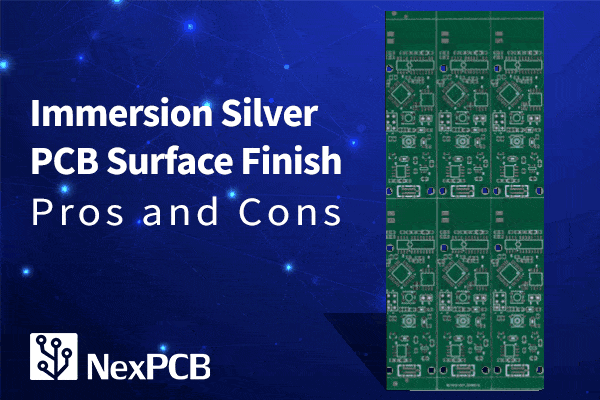Immersion Silver, also known as IM silver, IMag, or ENIAg, among its other names, refers to the process of depositing a thin layer of silver on the copper finishes of PCB through a chemical reaction. The process is realized based on the potential difference between silver and copper to allow copper and silver to spontaneously undergo a displacement reaction. The chemical reaction of Immersion Silver reads as follows:
2Ag++Cu═Ag+Cu2+
Basics of Immersion Silver
Immersion Silver is a transitional technique between OSP and ENIG in terms of functional performance (The Immersion Silver surface shows excellent weldability for soldering and exceptional solder joint strength while there is no conductive barrier like OSP. However, it does show strength inferiority to gold when used as a contact surface).
The process is simpler and faster. Immersion Silver is a displacement reaction that sees a layer of pure silver coated on a sub-micron level (5~15μin, which is about 0.1~0.4μm). Sometimes the Immersion Silver process would also contain some organic matter, which is added to prevent silver corrosion and eliminate silver migration. It is generally difficult to measure out this thin layer of organic matter, as analysis shows that the weight of the organic body is less than 1%.
The Immersion Silver finish provides good electrical properties and maintains excellent weldability for soldering even when exposed to heat, moisture, and contamination. However, it is not anti-tarnishing. As there is no nickel under the silver finish,
Immersion Silver cannot compete with ENIG in terms of physical strength. An important drawback of Immersion Silver is the electron migration of silver. When exposed to moisture, silver is susceptible to electromigration when applied voltage. The problem can be solved by adding organic components to the silver to ease electromigration.
Pros and Cons of Immersion Silver Surface Finish
Pros
- Immersion finish, excellent flatness (especially compared to HASL)
- Good for fine pitch / BGA / smaller components
- Middle range cost for lead-free finish
- Reworkable
- Medium shelf storage life when properly packaged
Cons
- Very sensitive to handling/tarnishing/cosmetic concerns – gloves must be used
- Special packaging required – if the package is opened and not all boards used, it must be resealed quickly.
- Short operating window between assembly stages
- Not recommended using peelable masks
- Reduced supply chain options to support this finish
When Should You Use Immersion Tin Surface Finish
- When the PCB line has a relatively narrow trace width/pad pitch.
- For products with high-speed signals, Immersion Silver is a better option for communication, automobile, computer, and other products.
- For complex PCBs with QFN or BGA packages, Immersion Silver will be a better choice.
- For PCB built for commemorative or other special purposes, the Immersion Silver surface delivers a unique and refreshing touch.
What our engineers think about Immersion Silver
Immersion Silver is slightly cheaper than ENIG. If the PCB has functional requirements connection-wise and the need to reduce costs, it is a good choice. Coupled with the fact that Immersion Silver surface usually has excellent flatness and joint strength, it is considered an ideal option in many cases.
There are many applications of Immersion Silver in PCB products. Some common examples are communication, automobile, and computer peripherals industries, as well as high-speed signal design. Since it possesses exceptional electrical properties that other surface treatment doesn't, Immersion Silver can also be used in high-frequency signals.
NexPCB recommends the Immersion Silver treatment for its superior ease-of-assembly and inspectability. However, the defects of Immersion Silver, such as sensitivity to tarnishing and voids in solder joints, have slowed down the growth of its application (yet not declining). It is estimated that about 10% of PCBs currently adopt the Immersion Silver treatment.


